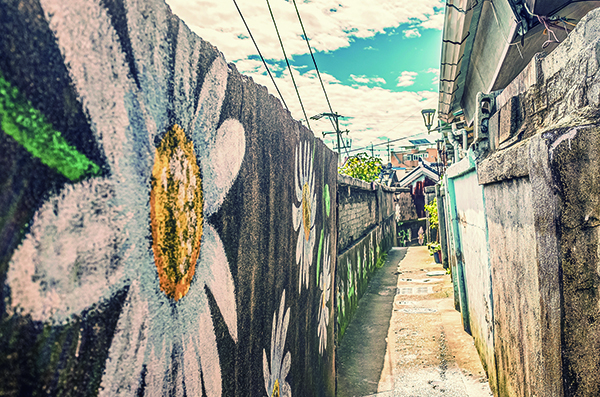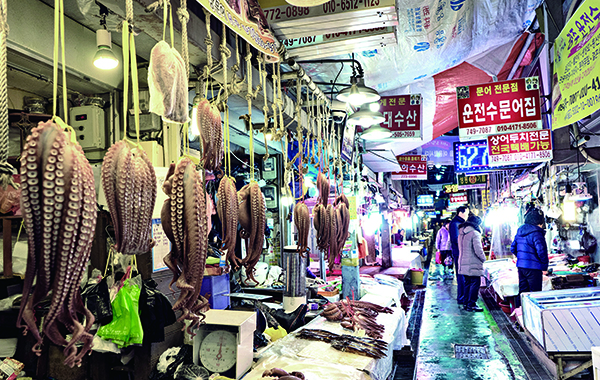 |
| Gampo Haeguk-gil is a great place to walk. Photo by Gapsu Choi |
It's spring. Soon Gyeongju will be covered with cherry blossoms. It's not worth the effort of walking a long way just to see the cherry blossoms this spring. Let’s go to Haeguk-gil, which is still a little less known. You can also enjoy a sea drive. Your itinerary will be more enriched if you taste delicious Gyeongju food at Seongdong Market in Gyeongju.
A good road to walk right now
There is ‘Gampo Kkakjigil’ in Gyeongju. It is a road that connects the coast and villages centered on Gampo Port. Among these, section 4, ‘Haeguk-gil’, is a road that preserves the atmosphere of an old alley. Between buildings with low slate roofs, a winding road that can barely accommodate one person passes. It's not long, about 600m, but as the name suggests, it's a lot of fun walking while looking at sea guksu painted on every wall. Even if you walk slowly, 30 minutes is enough.
The alley begins across from Gampo Public Market, located in front of Gampo Port. There is a small sign on the wall, and you can easily find it by asking nearby merchants. You can walk in the following order: Haeguk Alley, Haeguk Stairs, old building's basement warehouse, Damuleun House, Hancheontang, Well Saem, and Pine Tree House. The alley is just as narrow as it looks from the outside. There are many places that are barely wide enough for one person to pass through, and you have to turn your body sideways to get through. Rough cement was applied to the road. There are small houses on both sides of the alley, with gates barely large enough for a single person to enter, and windows the size of paintings.
Seagulls were painted on every wall along the alley. The colors and shapes are all different. There is white sea guk and there is also purple sea guk. The color of haeguk, whose color has faded as time has passed, is also noticeable. As fall deepens, a bunch of real sea guks bloom in front of a picture of sea guk, welcoming travelers.
As you walk along the alley, your view becomes clearer and you come across a path with a large beetle drawn on the ground. If you go up the slope to the left, there is a church and playground, and from here you can see Gampo Port and the East Sea. If you go down the road to the right a little bit, you will come to a staircase with a large sea guksu painted on it. This is the most popular photo zone on Haeguk-gil, and travelers take photos to make memories.
If you pass the stairs and follow the alley, you will see a building that shows the depth of time. On the wall of a building with a brown door, there is a sign that reads ‘Old Building Basement Storage.’ It is said that the building was used as a shelter and underground warehouse. There is a Japanese-style house called ‘Damul-eun House’ 2-3 minutes away from here. Originally, the area around Haeguk-gil was where a Japanese immigrant fishing village was formed after the port was opened in the 1920s, and it is said to have been the busiest street at the time. Damuleun House is a remnant of a village built by Japanese fishermen. Walking along Haeguk-gil, it is not difficult to see old Japanese houses, which are now used as soup restaurants, pharmacies, and laundromats.
The building located across from Damuleun House catches the eye with its towering chimney. It was a building that was used as a bathhouse, but no one lives there now. If you follow the road next to the building for about 100 meters, you will find the site of an old well. There is a bucket and the water is flowing in the well, but it is not drinkable. It is said to be a well that was commonly used by villagers during the Japanese colonial period.
Songdaemal Lighthouse is located about 10 minutes north of Gampo Port across Haeguk-gil. Songdaemal means ‘the end of a pine tree’. As the name suggests, there are pine trees at the edge of the cliff curved like dragons, and between them, the blue East Sea washes over with white waves. If you pass through the pine forest and go down close to the cliff, you will see two pure white lighthouses. Above the management office building on the left is a new lighthouse modeled after the three-story stone pagoda of Gameunsaji Temple, and next to it is an old lighthouse built in 1955 as an unmanned lighthouse. The scenery of the black rocks and the sea below the lighthouse is beautiful. Anglers spend leisurely time on the rocks.
You can leave Songdaemal Lighthouse, see King Munmu's Tomb and Gameunsa Pagoda in Gyeongju, and then take a tour of downtown Gyeongju. The Tomb of King Munmu is where King Munmu, who completed the unification of the three kingdoms, is buried, saying that he would become a dragon and protect the country even after death. It is also famous as a sunrise travel destination. On the way from the Royal Tomb of King Munmu to downtown Gyeongju, there is the Gameunsa Pagoda, which is called the 'typical Silla pagoda' for its perfect formative beauty. The formative beauty of Gameunsa Pagoda, which has nothing to add or take away, fascinates the viewer.
Gyeongju’s Kitchen, Seongdong Market
It is said that the world's people have become harsh, but if you are looking for a place where people's hearts and affection still remain, it would be the traditional market. As I walk through the bustling alleys of the market, I feel as if my energy is rising and my heart is naturally enriched.
In Gyeongju, the thousand-year-old city, there is a market full of people. Seongdong Market is the representative market of Gyeongju. Since the market is just across the railroad crossing from Gyeongju Station, it is visited by many tourists as well as Gyeongju citizens.
Originally, Seongdong Market was located where the Myeongdong Clothing Market is now located in the city center. The size was also small, about 1,300 m2 (400 pyeong). It was called Yeommae Market because it sold only cheap items such as clothing, tools, and simple food. Yeommae is an abbreviation for ‘cheap sale.’
Seongdong Market moved to its current location in 1971. At the time, it was not a large market, measuring about 3,300 m2 (1,000 pyeong). Then, as Gyeongju City grew, the market grew along with it. It is now considered the best market in Gyeongju, covering approximately 13,223 m2 (4,000 pyeong). There are about 600 stores in Food Alley, Fish Alley, Pyebaek Food Alley, Vegetable Alley, and Clothing Alley, and people from Gyeongju as well as Eonyang and Ulsan come here.
 |
| Seongdong Market filled with octopuses. Photo by Gapsu Choi |
The most eye-catching thing at Seongdong Market is the large octopus hanging in each fish pancake. In the Gyeongbuk region, which has a strong Confucian tradition, octopus must be prepared for major events such as family rites or ancestral rites. Cut the octopus legs in half, place them neatly on skewers, and place them on the table along with beef and shark meat. This is because the character ‘geulwol (文)’ in the name of the octopus symbolizes a scholar. In the past, octopus ink was actually used as a substitute for food.
There are also pieces of fish that look like tuna, which are shark meat that has been pickled and aged in salt. In the Gyeongbuk region, including Gyeongju, Andong, Yeongju, Yeongcheon, Bonghwa, and Cheongsong, it is called 'Dombegi' or 'Dombegogi'. There is a saying that sea bream was made by cutting shark meat into 'dombak, sea bream,' and there is also a theory that it originated from 'sea bream shark.' Just as 'skate' is not missing from Jeolla-do's ancestral rites, 'Dombegi' is not missing from Gyeongsang-do's ancestral rites.
A better race on foot
Gyeongju is a great city to travel on foot. The Silla Grand Bell is said to be a reproduction of the King Seongdeok Divine Bell, National Treasure No. 29. It is 3.66m tall, has an average thickness of 20.3cm, and weighs a whopping 20.17 tons. This bell, which began to be made during the reign of King Gyeongdeok of Silla and was completed during the reign of King Hyegong, must have awakened Seorabeol in the morning and comforted it in the exhaustion of the evening for over 1,200 years. How did people make this huge bell back then? I try to guess his feelings, but it is not easy to understand. I imagine the sound of the bell and walk toward Daereungwon.
I think what makes Gyeongju worthy of being a ancient city is the group of royal tombs, including Daereungwon. Gyeongju is the world's best tomb city. The city is built between tombs such as the Noseo and Nodong-dong tombs, Daereungwon, Hwangori tombs, Hwangnam-ri tombs, King Naemul's tomb, and Oreung.
When you leave Daereungwon, you will reach Hwangridan-gil. It is the trendiest place in Gyeongju. There are many cafes, restaurants, souvenir shops, and independent bookstores. It gets very crowded starting around evening. Director Hong Sang-soo also filmed his movie ‘Discovery of Life’ here.
If you cross Hwangridan-gil, you will reach Cheomseongdae. After Cheomseongdae, you will reach Gyerim, and soon you will reach Wolseong. Wolseong is the site of the Silla palace, and when you climb up here, you can see the entire city of Gyeongju, including Daereungwon and Hwango-dong.
No comments:
Post a Comment